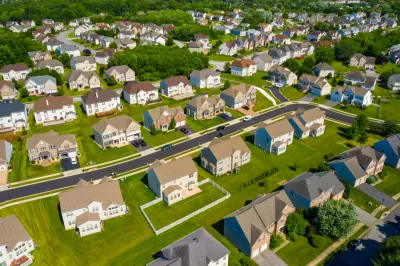A counterintuitive argument contends that from a housing justice perspective, the Biden administration's attack on exclusionary zoning is imprudent.

Joe Biden is now the 46th president of the United States. I join many, likely most, of those in the community of scholars and reflective practitioners concerned with the sorry state of American housing policy in saying “good riddance” to our former president. And breathing an enormous sigh of relief.
YIMBYs, as well as many advocates for housing justice, have cheered a key provision in Biden’s housing plan that targets “exclusionary zoning” (EZ) for elimination. EZ, according to his plan, must go because it “perpetuate[s] discrimination” that “for decades [was used] strategically … to keep people of color and low-income families out of certain communities.”
In a recent article in Urban Affairs Review (UAR)—under the Strangelovian title “Rethinking Exclusionary Zoning or: How I Stopped Worrying and Learned to Love It”—I counterintuitively contended that, from a housing justice perspective, the attack on EZ is imprudent. In my choice of title I was, as I said at the outset of the article, of course being “deliberately provocative and more than a bit facetious.” Overly restrictive zoning can certainly be a source of harms. Rather than “love” EZ, my central claim was that we should simply come to accept it—and thus stop worrying about it so much compared to other much more virulent and insidious forces that militate against housing justice in drastically more significant ways.
UAR editor Jered Carr solicited responses from three smart housing experts with contrasting viewpoints—Katherine Levine Einstein, Edward Goetz, and Rolf Pendall. These, along with a reply from me, will appear in print just as the new Biden administration, with its plan to eliminate EZ in hand, assumes office. To mark the occasion, Shelterforce invited me to revisit my argument here.
I contend that the effort to eliminate EZ—what I dub the Anti-EZ Project—embraces a worldview whose actualization would be far more detrimental to the cause of housing justice (and social justice more broadly) than the actual impacts of EZ. While it is clear that EZ measures often (though not always) both reflect and perpetuate the ubiquitous racism and white supremacy that profoundly corrupt the promise of America, the project to eliminate them inflicts a greater degree of racialized suffering upon those disadvantaged by both class standing and skin color. In short, the Anti-EZ cure is worse—much worse, in fact—than the EZ disease.
Why? My argument boils down to this:
....
FULL STORY: Say It Ain’t So, Joe: Biden’s Ill-Advised Plan to Eliminate Exclusionary Zoning

Planetizen Federal Action Tracker
A weekly monitor of how Trump’s orders and actions are impacting planners and planning in America.

San Francisco's School District Spent $105M To Build Affordable Housing for Teachers — And That's Just the Beginning
SFUSD joins a growing list of school districts using their land holdings to address housing affordability challenges faced by their own employees.

The Tiny, Adorable $7,000 Car Turning Japan Onto EVs
The single seat Mibot charges from a regular plug as quickly as an iPad, and is about half the price of an average EV.

Seattle's Plan for Adopting Driverless Cars
Equity, safety, accessibility and affordability are front of mind as the city prepares for robotaxis and other autonomous vehicles.

As Trump Phases Out FEMA, Is It Time to Flee the Floodplains?
With less federal funding available for disaster relief efforts, the need to relocate at-risk communities is more urgent than ever.

With Protected Lanes, 460% More People Commute by Bike
For those needing more ammo, more data proving what we already knew is here.
Urban Design for Planners 1: Software Tools
This six-course series explores essential urban design concepts using open source software and equips planners with the tools they need to participate fully in the urban design process.
Planning for Universal Design
Learn the tools for implementing Universal Design in planning regulations.
Smith Gee Studio
City of Charlotte
City of Camden Redevelopment Agency
City of Astoria
Transportation Research & Education Center (TREC) at Portland State University
US High Speed Rail Association
City of Camden Redevelopment Agency
Municipality of Princeton (NJ)





























